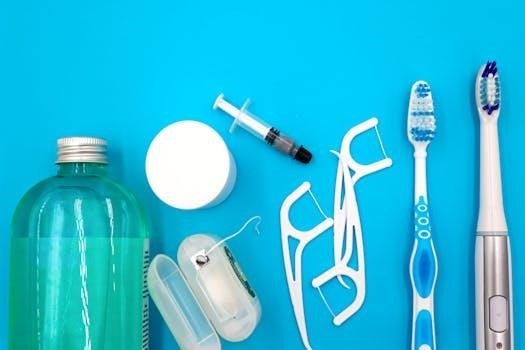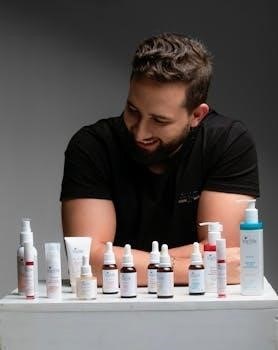After Fluoride Treatment Instructions⁚ A Comprehensive Guide
Fluoride treatment is a common dental procedure for strengthening enamel and preventing decay. This comprehensive guide provides essential post-care instructions to maximize treatment effectiveness and maintain optimal oral health, ensuring long-term benefits for your smile’s health and appearance.
What is Fluoride Varnish?
Fluoride varnish is a highly concentrated topical fluoride treatment applied by dental professionals to prevent, slow down, or stop tooth decay. It contains fluoride, calcium phosphate, and a protective coating for tooth surfaces. The varnish creates a thin coating visible on the teeth and remains effective for four to six hours.
This treatment delivers fluoride directly to the enamel, strengthening it and making it more resistant to acid attacks from bacteria and sugars. Unlike some fluoride treatments, fluoride varnish is safe if swallowed in small amounts. It’s a common preventive measure, especially beneficial for children and individuals prone to cavities.
Fluoride varnish application is quick and painless, making it a convenient option for patients of all ages. By providing a concentrated dose of fluoride, it aids in remineralizing weakened areas and protecting against future decay, contributing to overall oral health and long-term dental well-being. This proactive approach strengthens tooth enamel.
Benefits of Fluoride Treatment
Fluoride treatment offers numerous benefits for individuals at risk of tooth decay. It strengthens tooth enamel, making it more resistant to acid attacks from bacteria and sugars, thus preventing cavities. Fluoride aids in remineralizing weakened enamel, repairing early signs of decay and reversing damage. It is effective for both children and adults.
The treatment provides a protective barrier, reducing tooth sensitivity and discomfort. Fluoride is a cost-effective preventive measure, reducing the need for extensive dental work. It is especially beneficial for individuals with dry mouth, braces, or a history of frequent cavities. Fluoride is a natural mineral found in water and soil.
Professional fluoride treatments offer a higher concentration than over-the-counter products. They are a safe and efficient way to enhance oral health and maintain strong teeth. Regular fluoride treatments contribute to long-term dental well-being and reduce the risk of dental problems. Fluoride helps to maintain healthy teeth.
Immediate Aftercare Tips (First 30-60 Minutes)
Following fluoride varnish application, adhering to immediate aftercare tips is crucial for optimal results. Refrain from eating or drinking for at least 30-60 minutes post-treatment, allowing the fluoride to effectively seal to the teeth. Avoid hot drinks and alcohol during this initial period to prevent interference with fluoride absorption.
Do not smoke for at least 30 minutes, as it can compromise the treatment. Avoid any activities that might cause you to swallow, as the fluoride may cause nausea. It is important to allow the fluoride varnish to remain undisturbed on the tooth surfaces for maximum benefit during this critical treatment period.
This allows the fluoride to deliver calcium phosphate and provide a protective coating. The fluoride is still on your teeth. Proper immediate aftercare ensures the effectiveness of the fluoride varnish in preventing tooth decay. This is a crucial time for the treatment.
Dietary Considerations⁚ Foods to Avoid

After fluoride treatment, what you eat and drink significantly impacts its benefits. Certain foods and beverages can disrupt fluoride’s ability to protect your teeth. For the first four to six hours after treatment, it’s best to stick to soft foods. Avoid any very hot, cold, spicy, or acidic foods that may cause sensitivity.
Specifically, refrain from consuming hard, sticky, or chewy foods that could potentially remove the fluoride coating. Acidic fruits, juices, and sodas should also be avoided, as they can interfere with the remineralization process. It’s best to skip alcoholic beverages. Maintaining these dietary restrictions will help preserve the fluoride’s protective effects.

These considerations are essential for ensuring the treatment’s long-term effectiveness. Proper dietary choices during this period will support optimal oral health. This is a key step in ensuring you get the full benefit of the treatment. Remember that proper fluoride aftercare is fairly simple!
Foods to Eat After Fluoride Treatment
Following a fluoride treatment, selecting the right foods can aid in maximizing its benefits. Opt for soft foods that are gentle on your teeth and gums during the initial hours. Good choices include yogurt, mashed potatoes, applesauce, and well-cooked cereals. These options minimize disruption to the fluoride coating while providing essential nutrients.
Smoothies or protein shakes can be a great way to get the nutrients your body needs without jeopardizing the fluoride treatment. Soups are another excellent choice, ensuring they are not excessively hot. Remember, the goal is to allow the fluoride to fully absorb into the tooth enamel.

By choosing easy-to-consume and non-abrasive foods, you’re supporting the remineralization process. This will allow the fluoride to work its magic in strengthening your teeth. These choices will help ensure that the fluoride remains on your teeth for the recommended time.
How Long to Wait Before Eating or Drinking
After receiving a fluoride treatment, it’s crucial to wait a specific amount of time before eating or drinking. Typically, dentists recommend waiting at least 30 to 60 minutes after the fluoride application. This waiting period allows the fluoride to fully absorb into the tooth enamel, maximizing its protective benefits against tooth decay.
During this time, avoid consuming any foods or beverages, including water. This ensures that the fluoride coating remains undisturbed, enabling it to effectively strengthen your teeth. Refraining from eating or drinking too soon can compromise the fluoride’s ability to work effectively.
Following the recommended waiting time is a simple yet vital step in ensuring the success of your fluoride treatment. Adhering to these guidelines contributes to long-term dental health by allowing the fluoride to properly remineralize and protect your teeth from acid attacks. This is why it’s so important to follow your dentist’s advice.
Brushing and Flossing After Fluoride Treatment
After a fluoride treatment, it’s important to adjust your regular brushing and flossing routine to ensure the treatment’s effectiveness. Dentists generally advise refraining from brushing or flossing for at least six hours following the procedure. Ideally, waiting until the next morning before resuming your normal oral hygiene practices is best.
This waiting period allows the fluoride varnish to remain undisturbed on the teeth, maximizing its contact time with the enamel. Brushing or flossing too soon after the treatment can disrupt the fluoride layer, reducing its ability to strengthen the teeth and protect against decay.
Once the recommended waiting time has passed, you can resume your regular brushing and flossing routine. Use a soft-bristled toothbrush and fluoride toothpaste to gently clean your teeth. Floss carefully to remove any plaque or debris from between your teeth. Maintaining consistent oral hygiene is crucial for long-term dental health.

Alcohol Consumption After Fluoride Treatment
Following fluoride treatment, it is generally recommended to avoid consuming alcohol for a certain period. Most dentists advise refraining from alcohol intake for at least six hours post-treatment. This precaution is due to alcohol’s potential to interfere with the fluoride’s effectiveness and its impact on oral health.
Alcohol can have a drying effect on the mouth, reducing saliva production. Saliva plays a crucial role in neutralizing acids and remineralizing teeth, complementing fluoride’s protective action. Reduced saliva flow can hinder fluoride’s ability to strengthen enamel and prevent decay.
Additionally, some alcoholic beverages are acidic, potentially eroding tooth enamel. Consuming acidic drinks shortly after fluoride treatment can counteract the fluoride’s benefits. It’s best to wait until the fluoride has fully set and the mouth has returned to its normal pH level before consuming alcohol.
If you have specific concerns about alcohol consumption after fluoride treatment, consult your dentist for personalized advice.
What to Expect⁚ Feeling the Coating
After receiving a fluoride varnish treatment, it is common to feel a thin coating on your teeth. This coating is the fluoride varnish itself, which is designed to adhere to the tooth surfaces and release fluoride over a period of several hours. The sensation can vary from person to person, but generally, it is described as a slightly rough or sticky feeling.
The coating may also have a slight taste, which is typically mild and not unpleasant. The color of your teeth might appear slightly different as well, often appearing a bit yellowish or off-white due to the varnish. This change in color is temporary and will disappear as the varnish wears off.
It is important to remember that the coating is meant to stay on your teeth for a certain duration, usually four to six hours, to provide maximum benefit. Avoid intentionally rubbing or picking at the coating, as this can reduce its effectiveness. The feeling of the coating is a normal part of the fluoride treatment process and indicates that the fluoride is actively working to protect your teeth.
Potential Side Effects and Concerns
While fluoride treatments are generally safe, some individuals may experience mild side effects. The most common side effect is slight nausea if a significant amount of fluoride is swallowed, particularly in children. This is why it’s important to avoid eating or drinking for at least 30 minutes after treatment, minimizing the chance of swallowing excess fluoride.
In rare cases, some people may have an allergic reaction to the fluoride varnish, resulting in a rash, itching, or swelling. If you experience any of these symptoms, seek medical attention immediately. Another potential concern is fluorosis, which can occur from excessive fluoride exposure during tooth development. This is more common in children who ingest too much fluoride from sources like toothpaste or fluoridated water.
To minimize risks, always follow your dentist’s instructions carefully. Avoid using excessive amounts of fluoride toothpaste, and supervise young children during brushing to ensure they don’t swallow the toothpaste; If you have any concerns about fluoride treatment, discuss them with your dentist to determine the best course of action for your oral health.

